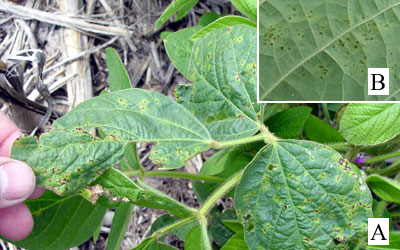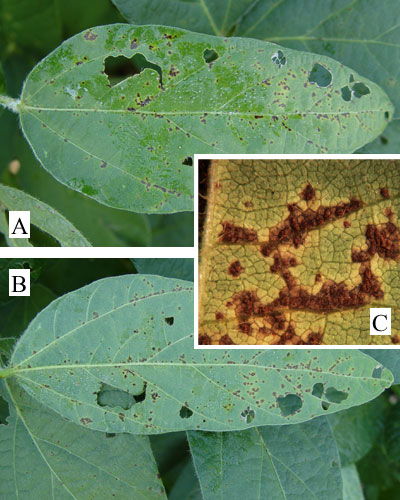G2058
Bacterial Diseases of Soybean
Symptoms, epidemiology, identification, and management of Nebraska’s two most prominent bacterial diseases in soybean — bacterial blight and bacterial pustule — are discussed in this NebGuide.
Loren J. Giesler, Extension Plant Pathologist
Soybeans are planted on millions of acres of farmland each year in Nebraska. Their growth and health can be affected by several diseases, including bacterial blight and bacterial pustule, the most prominent soybean bacterial diseases in Nebraska. While these two diseases share some similar characteristics, a careful examination can differentiate one from the other (Table I) as well as from other diseases. Both of these foliar diseases can start in the lower portion of the canopy and may be confused with Septoria leaf spot or soybean rust.
| Table I. Comparison of bacterial disease characteristics of soybean. | ||
| Characteristics | Bacterial Blight | Bacterial Pustule |
| Overwinters | Crop residue | Crop residue |
| Initial Symptoms | Yellow-brown spots with water soaked underside of leaf lesion | Tiny pale green spots on leaves |
| Later Symptoms | Irregularly shaped lesions with water-soaked tissue and yellow halo | Circular spots with elevated centers |
| Optimum Temperatures | 70-80°F | 86-92°F |
Bacterial Blight
Bacterial blight of soybean is caused by the bacterium Pseudomonas syringae pv. glycinea. It was first reported in Nebraska in 1906 and is now the most common soybean bacterial disease in the state. Although yield loss from bacterial blight is seldom observed, economic losses can occur when soybeans are grown for seed. The disease is most prevalent early in the season. Symptoms Plants infected early in the growing season are characterized by brown spots on the margins of the cotyledons. Young plants may be stunted, and if the infection reaches the growing point, they may die. Symptoms in later growth stages include angular lesions, which begin as small yellow to brown spots on the leaves (Figure 1A). The centers of the spots will turn a dark reddish-brown to black and dry out. A yellowish-green “halo” will appear around the edge of the water-soaked tissue (Figure 1B) that surrounds the lesions. Eventually, the lesions will fall out of the leaf and the foliage will appear ragged. Generally, young leaves are most susceptible to blight infection. The disease rarely affects seeds, but when lesions do appear on pods, developing seeds may become shriveled and discolored. Both Septoria leaf spot and soybean rust start in the lower canopy. However, bacterial blight will be in the mid to upper canopy and have green leaves below the affected area as the crop goes into the flowering stage of development.
|
Epidemiology
Bacterial blight of soybeans is typically an early season disease. It overwinters in the field in plant residue. Initial infection of soybeans occurs when bacterial cells are carried by splashing or wind-driven water droplets from plant residue on the soil surface to the leaves. Disease outbreaks usually follow rainstorms with high winds. The bacteria enter the plants through stomata (natural openings) and wounds on leaves. In order for infection to occur, the leaf surface must be wet. Seedlings may be infected through infested seed. Infecting bacteria produce a toxin, which prevents chlorophyll production and gives the yellowish halo to the lesion. Bacteria also can be directly spread from infected leaves to uninfected leaves when they rub against one another during cultivation (especially when there is dew), rain, or wind.
Development of bacterial blight is promoted by cool, wet weather (70-80°F). Infection may occur at any time during the growing season, but is most common early in the growing season and will continue until hot, dry weather limits disease development.
Bacterial Pustule
Bacterial pustule, which is caused by Xanthomonas axonopodis (syn. campestris) pv glycines, can cause premature defoliation and reduced seed size and quantity. This disease has been reported in most parts of the world where soybeans are grown and the climate is warm with frequent rain. It is most prevalent later in the growing season.
Symptoms
Initial symptoms are the appearance of tiny pale green spots on leaves. These spots have raised centers that may develop on either surface of the leaf but are more common on the lower surface. Lesions are often associated with main leaf veins (Figure 2A and 2B). As the disease progresses, small, light-colored pustules will form in the center of the spots (Figure 2C). Spots may merge together to form irregular lesions. This disease can easily be confused with soybean rust. Mature soybean rust pustules have a small, round opening at the top for spore release. Bacterial pustule lesions normally lack an opening and do not produce spores. If an opening is present with bacterial pustule, it is typically a linear crack across the surface of the pustule. These features can only be seen under magnification (20X recommended). Symptoms of bacterial pustule are very similar to those of bacterial blight during the early stages of development, but water soaking will not be present with bacterial pustule, and bacterial pustule lesions will have raised centers as they develop.
Epidemiology
Like bacterial blight, bacterial pustule overwinters in crop residue and is carried by wind-driven rain or water droplets splashing from the ground to the plant. In addition, the disease can be spread during cultivation while the foliage is wet. The bacterium will enter the plant through natural openings and wounds. Warm weather with frequent showers promotes the development of this disease. Unlike bacterial blight, warm temperatures do not limit development of bacterial pustule. Its optimal temperature range for development is 86-92°F.
Bacterial Disease Management
While these diseases are not typically yield limiting in Nebraska, producers should consider the following options in problem fields:
- Resistance. Cultivars that are not highly susceptible to the disease should be considered in fields with a history of bacterial disease problems.
- Crop rotation. Crop rotation can be an effective method to avoid inoculum from a previously infected crop.
- Tillage. Incorporating crop residue by tillage will reduce the amount of inoculum available in the spring to infect plants.
- Cultivation. To prevent the spread of disease, limit cultivation to times when the foliage is dry.
- Fungicides. Copper fungicides are labeled for con- trol of bacterial blight on soybeans but need to be applied early in the disease cycle to be effective.
Acknowledgment
The author would like to acknowledge the work of Tom J. Weissling, former postdoctoral research associate, who contributed to the original edition of this publication.
This publication has been peer reviewed.
Visit the University of Nebraska–Lincoln Extension Publications Web site for more publications.
Index: Plant Diseases
Field Crops
Issued May 2011

